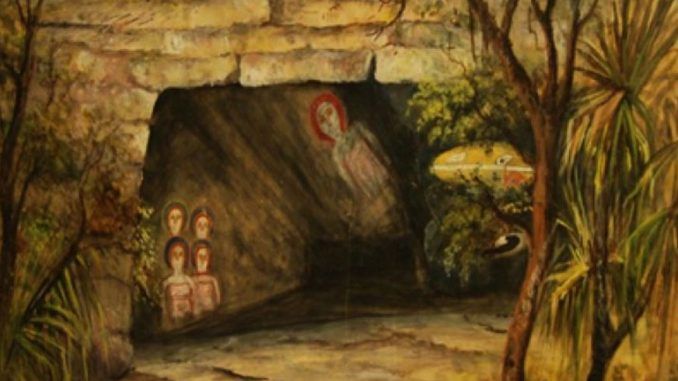
Aboriginals in Australia are attempting to reclaim a sacred image that depicts aliens in the early days of British exploration.
The Wandjina are cloud and rain spirits drawn on cliffs and cave walls throughout Western Kimberley, dating back around 4,000 years.
It is commonly believed amongst UFOlogists that these Wandjina may represent alien beings sent to Earth.

BYPASS THE CENSORS
Sign up to get unfiltered news delivered straight to your inbox.
You can unsubscribe any time. By subscribing you agree to our Terms of Use
Abc.net.au reports:
Worrora woman Leah Umbagai said they were considered sacred by three tribes in the area.
“The Wandjina is a supreme being that created the country, gave us the laws of the land, and we have to obey and follow it,” she said.
“The Wandjina is not just a big picture on the wall, it’s the trees, it’s the rocks, it’s the water, it’s the seasons, it’s everything … it lets us Wandjina people know who we are, and how to live our life.”
But the history of white contact with the Wandjina is marred by misunderstanding and wild theories that remain deeply hurtful to the Worrora, Ngarinyin and Wununbul tribes to this day.
British explorer seeking ‘inland sea’ stumbles upon artwork
In 1837, explorer George Grey embarked on a bold but misguided mission to penetrate north-western Australia.
It was thought a large, inland sea might exist in central Australia, and the British government and the Royal Geographical Society sponsored Grey and his team to explore what is now the Kimberley region.
Author Mike Donaldson has written extensively on Kimberley rock art and its discovery by settlers.
“Grey and his men came straight from England and South Africa to the Kimberley, and to cut a long story short, they struggled to get inland, they had a mob of sheep that all died, their dogs died, and they were attacked by Aboriginal people at one point,” he said.
“But then somewhere along the line they just came across these Wandjina pictures on a cave.”
Grey sketched several of the Wandjina in his journal, complete with big rounds heads, halo-like head-pieces, large eyes, slim nose and no mouth.
The images caused quite a stir when they were published back in Great Britain.
“They were totally unlike anything that people had reported from Aboriginal rock art in Australia before,” Donaldson said.
“They thought they could not have been done by Aboriginal people.
“They thought they must have been done by shipwrecked sailors, or some other culture of people that visited here.”
He said one of the figures appeared to be wearing a full gown, and what Grey interpreted as writing on the headband, which people thought could be Arabic or Chinese.
“But it wasn’t anything of the sort, it was an older painting showing through, where the painting was wearing away a bit,” he said.
Pictures fuel Australian ‘alien’ landing theory
The misunderstanding fuelled theories Asiatic or Middle Eastern people at one time occupied the Australian continent, and set the scene for an even more offensive proposition — that the Wandjina were drawings of aliens that visited prior to white settlement.
The theory emerged in the 1968 book Chariots of the Gods? Unsolved Mysteries of the Past, which was written by Swiss author Erich von Daniken, and detailed examples of ancient civilisations that could be evidence of alien life form.
Donaldson said the theory never gained much traction.
“It was just ignorance on von Daniken’s part, the kind of ignorance that goes back to the people who initially, 100 years ago, thought that Aboriginal people were not so sophisticated enough to do those paintings,” he said.
“Of course we soon learnt that they were very sophisticated, and could paint all these wonderful things … so that’s just one guy’s crazy story, that thought they were space men or something.”
Traditional owners hope to educate public
It is a source of ongoing frustration for traditional owners like Ms Umbagai, who until recently managed the Mowanjum Art Centre.
“A lot of the people that come into the art centre, they ask so many questions, and yes I suppose there have been UFO sightings in America and all of that, but it just really saddens me that they say things about it,” she said.
“It’s like people are making fun, or think we’re making things up, and it’s hurtful for us.”
Efforts are underway to reclaim the image, including high-tech 3D imaging used to create a life-size Wandjina cave at the Mowanjum Art centre, so local Aboriginal children and tourists can learn about the importance of the rain-making spirit figure.
Families are finding ways to revisit the remote bush caves where the Wandjina live, to care for the sites and touch up the paintings.
It takes several days’ driving or an expensive helicopter charter to reach many of them, but native title agreements, marine parks and remote ranger programs are making the trips more possible.
Ms Umbagai has been able to visit the caves that featured in Grey’s journal more than 175 years ago.
“When I’m out there, I’m just so at home. Because I’m at artist, I love sketching everything I come across, so I’ll just sit there are draw them myself,” she said.
“But just looking at the paintings and knowing that our old people used to walk this area and sit here, and knowing this is what they left for us … it’s very special.”


